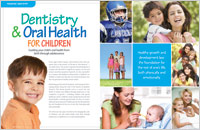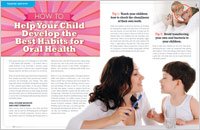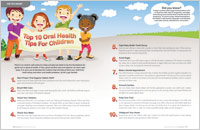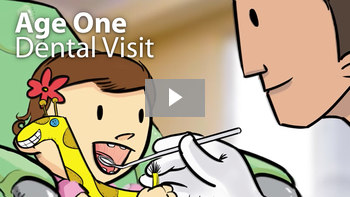
Tooth decay, the major cause of dental trouble that can eventually lead to tooth loss, is actually an infectious disease caused by bacteria. If it takes hold, it can form a cavity in the enamel and then progress deeper into the tooth — causing discomfort, difficulty eating and speaking, and a need for fillings or root canal treatment. The good news is that tooth decay (also called caries) is completely preventable.
The primary route to good dental health is plaque removal. Plaque is the sticky, whitish film that builds up on teeth in the absence of effective oral hygiene. Decay-causing bacteria thrive in plaque, where they break down any sugar that lingers in the mouth. In the process, they produce acid byproducts that erode teeth. This is how a cavity begins. What are the most effective techniques for plaque removal and decay prevention? That depends on the age of your child.
Babies
Babies can develop a form of tooth decay known as early childhood caries. This occurs when they are allowed to go to sleep with a bottle that’s filled with anything but water. The sugars in formula, milk (even breast milk) and juice can pool around the teeth and feed decay-causing bacteria. When it comes to bedtime soothing, a pacifier or bottle filled with water is safer for developing teeth — that is, until about age 3. At that point, sucking habits should be gently discouraged to prevent orthodontic problems from developing later on.
Brush your baby’s first teeth gently with a small, soft-bristled toothbrush, using just a thin smear of fluoride toothpaste, at least once a day at bedtime. Before a tooth is fully erupted, you can use a water-soaked gauze pad to clean around the tooth and gums.
Make sure your child has his or her first dental visit by age 1. There, you can learn proper hygiene techniques; have your youngster examined for signs of early decay; and get a recommendation for fluoride supplements if needed.
Children
Starting at age 3, you can begin teaching your child to brush with a children’s toothbrush and no more than a pea-sized amount of fluoride toothpaste. But remember, children will need help with this important task until about age 6, when they have the fine motor skills to do an effective job themselves.
It’s also extremely important to start encouraging healthy dietary habits at this time. Your child will have less plaque buildup and decay if you place limits on soda and sugary snack consumption. As a parent, you can model this behavior to instill it in your child. After all, monkey see, monkey do! Any sugary treats that are allowed should come at mealtimes, not in between. This will ensure your child is not creating favorable conditions for oral bacteria to grow around the clock.
At your child’s regular, twice-yearly dental checkups and cleanings, topical fluoride can be applied to strengthen tooth enamel and make it more resistant to erosion and decay. If necessary, dental sealants can be applied to the back teeth (molars) to prevent food particles and bacteria from building up in the tiny grooves where a toothbrush can’t reach (View Dental Sealant Video).
Teens
At this point, your children have the primary responsibility for maintaining their day-to-day dental health — but you can continue to help them make good dietary and behavioral choices. These include drinking plenty of water and avoiding soda, sports drinks and energy drinks, all of which are highly acidic; avoiding tobacco and alcohol; and continuing to visit the dental office regularly for cleanings and exams. This is particularly important if your teen wears braces, which can make it more difficult to keep teeth clean.
Remember, it’s never too soon to help your child develop good oral hygiene habits that will last a lifetime.
Related Articles

Dentistry and Oral Health for Children
Dear Doctor magazine brings you this wide-ranging overview of milestones and transitions in your child’s dental development. Learn how to protect your children from tooth decay, dental injuries, and unhealthy habits while getting them started on the road to a lifetime of oral health and general well-being… Read Article

How to Help Your Child Develop the Best Habits for Oral Health
Proper oral health habits are easy to learn — and lead to behaviors that result in lifelong dental health. And the time to begin is as soon as your child’s first baby teeth appear. From toothbrushing for your toddler to helping your teenager stay away from tobacco, Dear Doctor magazine offers the most important tips for healthy habit formation through childhood and beyond… Read Article

Top 10 Oral Health Tips for Children
There’s no need to wait until your baby actually has teeth to lay the foundations for good oral or general health. In fact, good nutrition and oral hygiene can start right away. It is up to you to develop the routines that will help protect your child from tooth decay and other oral health problems. So let’s get started… Read Article


